- Control group
- Without signal
- With signal
- Without control group
- Without deviations
- With deviations
MASH baseline code
Yuxin Zou
10/30/2018
Last updated: 2021-05-18
Checks: 7 0
Knit directory: Note/
This reproducible R Markdown analysis was created with workflowr (version 1.6.2). The Checks tab describes the reproducibility checks that were applied when the results were created. The Past versions tab lists the development history.
Great! Since the R Markdown file has been committed to the Git repository, you know the exact version of the code that produced these results.
Great job! The global environment was empty. Objects defined in the global environment can affect the analysis in your R Markdown file in unknown ways. For reproduciblity it’s best to always run the code in an empty environment.
The command set.seed(20180529) was run prior to running the code in the R Markdown file. Setting a seed ensures that any results that rely on randomness, e.g. subsampling or permutations, are reproducible.
Great job! Recording the operating system, R version, and package versions is critical for reproducibility.
Nice! There were no cached chunks for this analysis, so you can be confident that you successfully produced the results during this run.
Great job! Using relative paths to the files within your workflowr project makes it easier to run your code on other machines.
Great! You are using Git for version control. Tracking code development and connecting the code version to the results is critical for reproducibility.
The results in this page were generated with repository version 9ef391c. See the Past versions tab to see a history of the changes made to the R Markdown and HTML files.
Note that you need to be careful to ensure that all relevant files for the analysis have been committed to Git prior to generating the results (you can use wflow_publish or wflow_git_commit). workflowr only checks the R Markdown file, but you know if there are other scripts or data files that it depends on. Below is the status of the Git repository when the results were generated:
Ignored files:
Ignored: .DS_Store
Ignored: .Rhistory
Ignored: .Rproj.user/
Ignored: analysis/.Rhistory
Ignored: analysis/figure/
Untracked files:
Untracked: analysis/Li&Stephens.Rmd
Untracked: data/locus1563.RDS
Unstaged changes:
Modified: analysis/LD_space.Rmd
Modified: analysis/amelialocus1563.Rmd
Modified: analysis/bibliography.bib
Note that any generated files, e.g. HTML, png, CSS, etc., are not included in this status report because it is ok for generated content to have uncommitted changes.
These are the previous versions of the repository in which changes were made to the R Markdown (analysis/MASHbaselineCode.Rmd) and HTML (docs/MASHbaselineCode.html) files. If you’ve configured a remote Git repository (see ?wflow_git_remote), click on the hyperlinks in the table below to view the files as they were in that past version.
| File | Version | Author | Date | Message |
|---|---|---|---|---|
| Rmd | 9ef391c | zouyuxin | 2021-05-18 | wflow_publish(“analysis/MASHbaselineCode.Rmd”) |
| html | 43ebe81 | zouyuxin | 2021-03-30 | Build site. |
| Rmd | 221342a | zouyuxin | 2021-03-30 | wflow_publish(“analysis/MASHbaselineCode.Rmd”) |
| html | de67b36 | zouyuxin | 2018-12-11 | Build site. |
| Rmd | 86aed4d | zouyuxin | 2018-12-11 | wflow_publish(“analysis/MASHbaselineCode.Rmd”) |
library(mashr)Loading required package: ashrControl group
Without signal
set.seed(1)
data = sim_contrast1(nsamp = 10000, ncond = 10, err_sd = sqrt(0.5))
colnames(data$C) = colnames(data$Chat) = colnames(data$Shat) = c(paste0('T', 1:9), 'CTL')mash_data = mash_set_data(Bhat = data$Chat, Shat=data$Shat)
mash_data_L = mash_update_data(mash_data, ref=10)U.c = cov_canonical(mash_data_L)m = mash(mash_data_L, U.c, algorithm.version = 'R', optmethod = 'mixSQP') - Computing 10000 x 197 likelihood matrix.
- Likelihood calculations took 1.38 seconds.
- Fitting model with 197 mixture components.
- Model fitting took 7.37 seconds.
- Computing posterior matrices.
- Computation allocated took 0.16 seconds.length(get_significant_results(m))[1] 0# png(filename="../output/MASHbaselineFigures/SimpleContrastEqu_Cor.png", width = 700, height = 500)
barplot(get_estimated_pi(m),las = 2, cex.names = 0.7)
Indep.data = mash_set_data(Bhat = mash_data_L$Bhat)
U.c = cov_canonical(Indep.data)
Indep.model = mash(Indep.data, U.c, algorithm.version = 'R', optmethod = 'mixSQP') - Computing 10000 x 197 likelihood matrix.
- Likelihood calculations took 1.11 seconds.
- Fitting model with 197 mixture components.
- Model fitting took 5.12 seconds.
- Computing posterior matrices.
- Computation allocated took 0.09 seconds.length(get_significant_results(Indep.model))[1] 3507# png(filename="../output/MASHbaselineFigures/SimpleContrastEqu_Wrong.png", width = 700, height = 500)
barplot(get_estimated_pi(Indep.model),las = 2, cex.names = 0.7)
median:
delta.median = t(apply(data$C, 1, function(x) x - median(x)))
deltahat.median = t(apply(data$Chat, 1, function(x) x - median(x)))
data.median = mash_set_data(deltahat.median, Shat = sqrt(0.5))
U.c = cov_canonical(data.median)
m.median = mash(data.median, U.c, algorithm.version = 'R', optmethod = 'mixSQP') - Computing 10000 x 211 likelihood matrix.
- Likelihood calculations took 1.32 seconds.
- Fitting model with 211 mixture components.
- Model fitting took 5.93 seconds.
- Computing posterior matrices.
- Computation allocated took 0.09 seconds.length(get_significant_results(m.median))[1] 0With signal
set.seed(1)
data = sim_contrast2(nsamp = 12000, ncond = 10)mash_data = mash_set_data(Bhat = data$Chat, Shat=data$Shat)
mash_data_L = mash_update_data(mash_data, ref=10)U.c = cov_canonical(mash_data_L)m = mash(mash_data_L, U.c, algorithm.version = 'R') - Computing 12000 x 211 likelihood matrix.
- Likelihood calculations took 1.21 seconds.
- Fitting model with 211 mixture components.
- Model fitting took 8.23 seconds.
- Computing posterior matrices.
- Computation allocated took 0.16 seconds.length(get_significant_results(m))[1] 75barplot(get_estimated_pi(m),las = 2, cex.names = 0.7)
Indep.data = mash_set_data(Bhat = mash_data_L$Bhat)
U.c = cov_canonical(Indep.data)
Indep.model = mash(Indep.data, U.c, algorithm.version = 'R') - Computing 12000 x 211 likelihood matrix.
- Likelihood calculations took 1.08 seconds.
- Fitting model with 211 mixture components.
- Model fitting took 6.42 seconds.
- Computing posterior matrices.
- Computation allocated took 0.10 seconds.length(get_significant_results(Indep.model))[1] 4404barplot(get_estimated_pi(Indep.model),las = 2, cex.names = 0.7)
The RRMSE plot:
L = contrast_matrix(10, ref=10)
delta = data$C %*% t(L)
deltahat = data$Chat %*% t(L)
# png(filename="../output/MASHbaselineFigures/SimpleContrastNonNullRRMSE.png", width = 700, height = 500)
barplot(c(sqrt(mean((delta - m$result$PosteriorMean)^2)/mean((delta - deltahat)^2)),
sqrt(mean((delta - Indep.model$result$PosteriorMean)^2)/mean((delta - deltahat)^2))
), ylim=c(0,0.8), names.arg = c('commonbaseline','independent'), main = 'RRMSE plot')
# dev.off()sign.test.contrast = as.matrix(delta)*m$result$PosteriorMean
sign.test.icor = as.matrix(delta)*Indep.model$result$PosteriorMean
thresh.seq = seq(0, 1, by=0.0005)[-1]
contrast = matrix(0,length(thresh.seq), 2)
icor = matrix(0,length(thresh.seq), 2)
colnames(contrast) = colnames(icor) = c('TPR', 'FPR')
for(t in 1:length(thresh.seq)){
contrast[t,] = c(sum(sign.test.contrast>0 & m$result$lfsr <= thresh.seq[t])/sum(delta!=0), sum(delta==0 & m$result$lfsr <=thresh.seq[t])/sum(delta==0))
icor[t,] = c(sum(sign.test.icor>0 & Indep.model$result$lfsr <= thresh.seq[t])/sum(delta!=0), sum(delta==0 & Indep.model$result$lfsr <=thresh.seq[t])/sum(delta==0))
}
median:
delta.median = t(apply(data$C, 1, function(x) x - median(x)))
deltahat.median = t(apply(data$Chat, 1, function(x) x - median(x)))
data.median = mash_set_data(deltahat.median, Shat = sqrt(0.5))
U.c = cov_canonical(data.median)
m.median = mash(data.median, U.c) - Computing 12000 x 226 likelihood matrix.
- Likelihood calculations took 0.51 seconds.
- Fitting model with 226 mixture components.
- Model fitting took 7.91 seconds.
- Computing posterior matrices.
- Computation allocated took 0.20 seconds.length(get_significant_results(m.median))[1] 68Without control group
Without deviations
set.seed(1)
data = sim_contrast1(nsamp = 10000, ncond = 10, err_sd = 1)
colnames(data$C) = colnames(data$Chat) = colnames(data$Shat) = 1:10mash_data = mash_set_data(Bhat = data$Chat, Shat=data$Shat)
mash_data_L = mash_update_data(mash_data, ref='mean')U.c = cov_canonical(mash_data_L)m = mash(mash_data_L, U.c, algorithm.version = 'R') - Computing 10000 x 197 likelihood matrix.
- Likelihood calculations took 0.75 seconds.
- Fitting model with 197 mixture components.
- Model fitting took 4.49 seconds.
- Computing posterior matrices.
- Computation allocated took 0.08 seconds.length(get_significant_results(m))[1] 0# png(filename = '../output/MASHbaselineFigures/MeanEqu_Cor.png', width = 700, height = 500)
barplot(get_estimated_pi(m),las = 2, cex.names = 0.7)
# dev.off()Indep.data = mash_set_data(Bhat = mash_data_L$Bhat, Shat = sqrt(9/10))
U.c = cov_canonical(Indep.data)
Indep.model = mash(Indep.data, U.c, algorithm.version = 'R') - Computing 10000 x 197 likelihood matrix.
- Likelihood calculations took 0.84 seconds.
- Fitting model with 197 mixture components.
- Model fitting took 5.20 seconds.
- Computing posterior matrices.
- Computation allocated took 0.10 seconds.length(get_significant_results(Indep.model))[1] 0# png(filename = '../output/MASHbaselineFigures/MeanEqu_Wrong.png', width = 700, height = 500)
barplot(get_estimated_pi(Indep.model),las = 2, cex.names = 0.7)
# dev.off()median:
delta.median = t(apply(data$C, 1, function(x) x - median(x)))
deltahat.median = t(apply(data$Chat, 1, function(x) x - median(x)))
data.median = mash_set_data(deltahat.median, Shat = 1)
U.c = cov_canonical(data.median)
m.median = mash(data.median, U.c) - Computing 10000 x 211 likelihood matrix.
- Likelihood calculations took 0.39 seconds.
- Fitting model with 211 mixture components.
- Model fitting took 5.68 seconds.
- Computing posterior matrices.
- Computation allocated took 0.11 seconds.length(get_significant_results(m.median))[1] 0With deviations
generate_data = function(n, p, V, Utrue, err_sd=0.01, pi=NULL){
if (is.null(pi)) {
pi = rep(1, length(Utrue)) # default to uniform distribution
}
assertthat::are_equal(length(pi), length(Utrue))
for (j in 1:length(Utrue)) {
assertthat::are_equal(dim(Utrue[j]), c(p, p))
}
pi <- pi / sum(pi) # normalize pi to sum to one
which_U <- sample(1:length(pi), n, replace=TRUE, prob=pi)
Beta = matrix(0, nrow=n, ncol=p)
for(i in 1:n){
Beta[i,] = MASS::mvrnorm(1, rep(0, p), Utrue[[which_U[i]]])
}
Shat = matrix(err_sd, nrow=n, ncol=p, byrow = TRUE)
E = MASS::mvrnorm(n, rep(0, p), Shat[1,]^2 * V)
Bhat = Beta + E
return(list(B = Beta, Bhat=Bhat, Shat = Shat, whichU = which_U))
}set.seed(1)
n = 500
R = 10
err_sd = 1ncond = R; nsamp = n
b = rnorm(nsamp, sd=3)
B.all = matrix(rep(b, ncond), nrow = nsamp, ncol = ncond)
B.zero = matrix(0, nrow = nsamp, ncol = ncond)
B.two = B.zero
b2 = rnorm(nsamp, sd=3)
B.two[, 1:2] = b2
B.last = B.zero
b3 = rnorm(nsamp, sd=3)
B.last[, R] = b3
B = rbind(B.zero, B.all, B.two, B.last)
Shat = matrix(err_sd, nrow = nrow(B), ncol = ncol(B))
E = matrix(rnorm(length(Shat), mean = 0, sd = Shat), nrow = nrow(B),
ncol = ncol(B))
Bhat = B + E
row_ids = paste0("effect_", 1:nrow(B))
col_ids = 1:ncol(B)
rownames(B) = row_ids
colnames(B) = col_ids
rownames(Bhat) = row_ids
colnames(Bhat) = col_ids
rownames(Shat) = row_ids
colnames(Shat) = col_ids
simdata.10 = list(B = B, Bhat = Bhat, Shat = Shat)
null.ind = 1:1000
simdata.9 = simdata.10
simdata.9$B = simdata.10$B[,c(1:8,10,9)]
simdata.9$Bhat = simdata.10$Bhat[,c(1:8,10,9)]
simdata.9$Shat = simdata.10$Shat[,c(1:8,10,9)]
# true cov
Utrue1 = matrix(0,R,R)
Utrue1[1:2,1:2] = 9
Utrue2 = matrix(0,R,R)
Utrue2[R,R] = 9
L.10 = contrast_matrix(R, 'mean')
L.9 = matrix(-1/R, R, R)
diag(L.9) = (R-1)/R
L.9 = L.9[c(1:8,10),]
Ulist.10 = list(U1 = L.10 %*% Utrue1 %*% t(L.10), U2 = L.10 %*% Utrue2 %*% t(L.10))
Ulist.9 = list(U1 = L.9 %*% Utrue1 %*% t(L.9), U2 = L.9 %*% Utrue2 %*% t(L.9))data.10 = mash_set_data(simdata.10$Bhat, simdata.10$Shat)
data.9 = mash_set_data(simdata.9$Bhat, simdata.9$Shat)Model 1
data.L.10 = mash_update_data(data.10, ref = 'mean')
U.c = cov_canonical(data.L.10)
m.1by1 = mash_1by1(data.L.10)
strong = get_significant_results(m.1by1)
U.pca = cov_pca(data.L.10, 3,subset=strong)
U.flash = cov_flash(data.L.10, subset = strong)
U.ed = cov_ed(data.L.10, c(U.pca, U.flash), subset=strong)
m.10 = mash(data.L.10, c(U.c,U.ed), algorithm.version = 'R') - Computing 2000 x 321 likelihood matrix.
- Likelihood calculations took 0.26 seconds.
- Fitting model with 321 mixture components.
- Model fitting took 3.80 seconds.
- Computing posterior matrices.
- Computation allocated took 0.04 seconds.# m.10 = mash(data.L.10, Ulist.10, algorithm.version = 'R')Model 2
data.L.9 = mash_update_data(data.9, ref = 'mean')
U.c = cov_canonical(data.L.9)
m.1by1 = mash_1by1(data.L.9)
strong = get_significant_results(m.1by1)
U.pca = cov_pca(data.L.9,3,subset=strong)
U.flash = cov_flash(data.L.9, subset = strong)
U.ed = cov_ed(data.L.9, c(U.pca, U.flash), subset=strong)
m.9 = mash(data.L.9, c(U.c,U.ed), algorithm.version = 'R') - Computing 2000 x 358 likelihood matrix.
- Likelihood calculations took 0.30 seconds.
- Fitting model with 358 mixture components.
- Model fitting took 4.50 seconds.
- Computing posterior matrices.
- Computation allocated took 0.03 seconds.#m.9 = mash(data.L.9, Ulist.9, algorithm.version = 'R')Model 3
L = contrast_matrix(R, ref='mean')
Indep.data.10 = mash_set_data(data.10$Bhat %*% t(L), Shat = sqrt(9/10))
U.c = cov_canonical(Indep.data.10)
m.1by1 = mash_1by1(Indep.data.10)
strong = get_significant_results(m.1by1)
U.pca = cov_pca(Indep.data.10,3,subset=strong)
U.flash = cov_flash(Indep.data.10, subset = strong)
U.ed = cov_ed(Indep.data.10, c(U.pca,U.flash), subset=strong)
A = rbind(diag(R-1),-1)
Indep.10 = mash(Indep.data.10, c(U.c,U.ed), algorithm.version = 'R', A=A) - Computing 2000 x 321 likelihood matrix.
- Likelihood calculations took 0.27 seconds.
- Fitting model with 321 mixture components.
- Model fitting took 3.88 seconds.
- Computing posterior matrices.
- Computation allocated took 0.03 seconds.# A = rbind(diag(R-1),-1)
# Indep.10 = mash(Indep.data.10, Ulist.10, algorithm.version = 'R', A=A)Model 4
L = contrast_matrix(R, ref='mean')
Indep.data.9 = mash_set_data(data.9$Bhat %*% t(L), Shat = sqrt(9/10))
U.c = cov_canonical(Indep.data.9)
m.1by1 = mash_1by1(Indep.data.9)
strong = get_significant_results(m.1by1)
U.pca = cov_pca(Indep.data.9,3,subset=strong)
U.flash = cov_flash(Indep.data.9, subset = strong)
U.ed = cov_ed(Indep.data.9, c(U.pca,U.flash), subset=strong)
A = rbind(diag(R-1),-1)
Indep.9 = mash(Indep.data.9, c(U.c,U.ed), algorithm.version = 'R', A=A) - Computing 2000 x 358 likelihood matrix.
- Likelihood calculations took 0.30 seconds.
- Fitting model with 358 mixture components.
- Model fitting took 4.88 seconds.
- Computing posterior matrices.
- Computation allocated took 0.04 seconds.# A = rbind(diag(R-1),-1)
# Indep.9 = mash(Indep.data.9, Ulist.9, algorithm.version = 'R', A=A)Model 5
L = contrast_matrix(R, ref='mean')
const.data.10 = mash_set_data(data.10$Bhat %*% t(L), Shat = 1)
U.c = cov_canonical(const.data.10)
m.1by1 = mash_1by1(const.data.10)
strong = get_significant_results(m.1by1)
U.pca = cov_pca(const.data.10,3,subset=strong)
U.flash = cov_flash(const.data.10, subset = strong)
U.ed = cov_ed(const.data.10, c(U.pca, U.flash), subset=strong)
A = rbind(diag(R-1),-1)
Const.10 = mash(const.data.10, c(U.c,U.ed), algorithm.version = 'R', A=A) - Computing 2000 x 321 likelihood matrix.
- Likelihood calculations took 0.26 seconds.
- Fitting model with 321 mixture components.
- Model fitting took 3.87 seconds.
- Computing posterior matrices.
- Computation allocated took 0.03 seconds.# A = rbind(diag(R-1),-1)
# Const.10 = mash(const.data.10, Ulist.10, algorithm.version = 'R', A=A)Model 6
L = contrast_matrix(R, ref='mean')
const.data.9 = mash_set_data(data.9$Bhat %*% t(L), Shat = 1)
U.c = cov_canonical(const.data.9)
m.1by1 = mash_1by1(const.data.9)
strong = get_significant_results(m.1by1)
U.pca = cov_pca(const.data.9,3,subset=strong)
U.flash = cov_flash(const.data.9, subset = strong)
U.ed = cov_ed(const.data.9, c(U.pca, U.flash), subset=strong)
A = rbind(diag(R-1),-1)
Const.9 = mash(const.data.9, c(U.c,U.ed), algorithm.version = 'R', A=A) - Computing 2000 x 358 likelihood matrix.
- Likelihood calculations took 0.32 seconds.
- Fitting model with 358 mixture components.
- Model fitting took 4.93 seconds.
- Computing posterior matrices.
- Computation allocated took 0.03 seconds.# A = rbind(diag(R-1),-1)
# Const.9 = mash(const.data.9, Ulist.9, algorithm.version = 'R', A=A)Likelihood
model 1 model 2 model 3 model 4 model 5 model 6
log likelihood -25321 -25329.51 -25994.5 -26669.72 -26053.95 -26744.97
# significance 361 357.00 226.0 395.00 208.00 355.00
# False positive 3 3.00 2.0 4.00 0.00 3.00barplot(get_estimated_pi(m.10), las=2)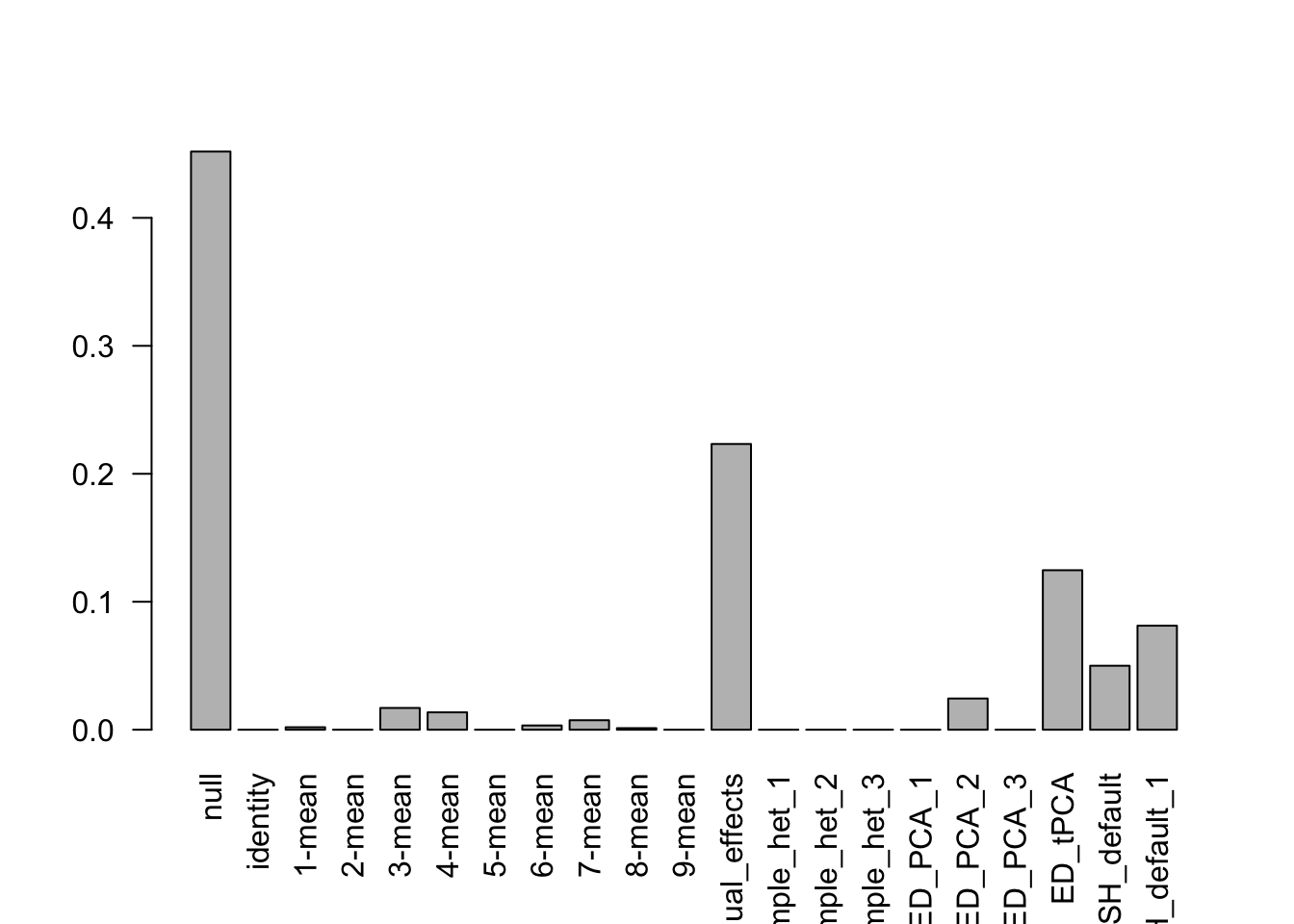
barplot(get_estimated_pi(m.9), las=2)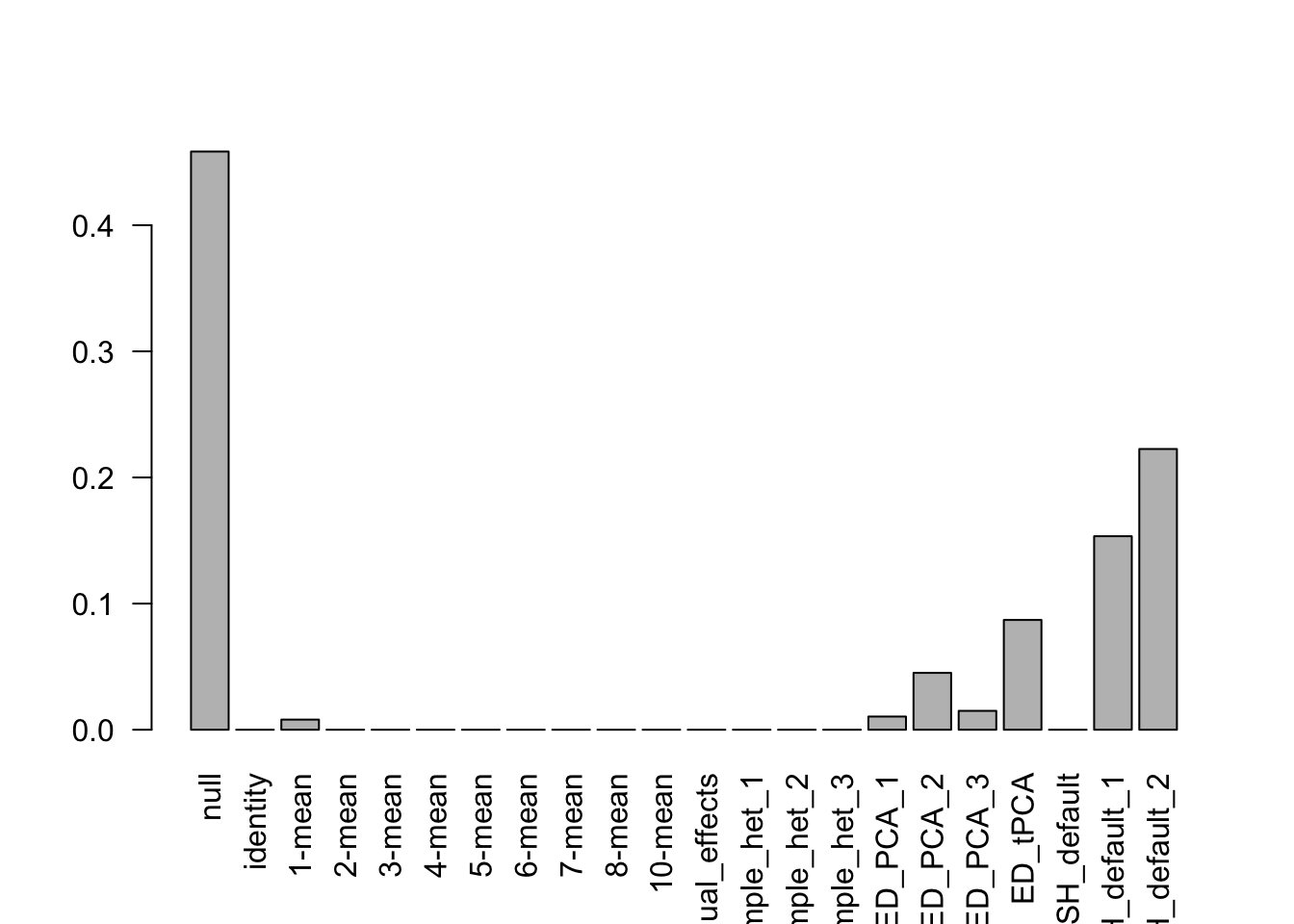
barplot(get_estimated_pi(Indep.10), las=2)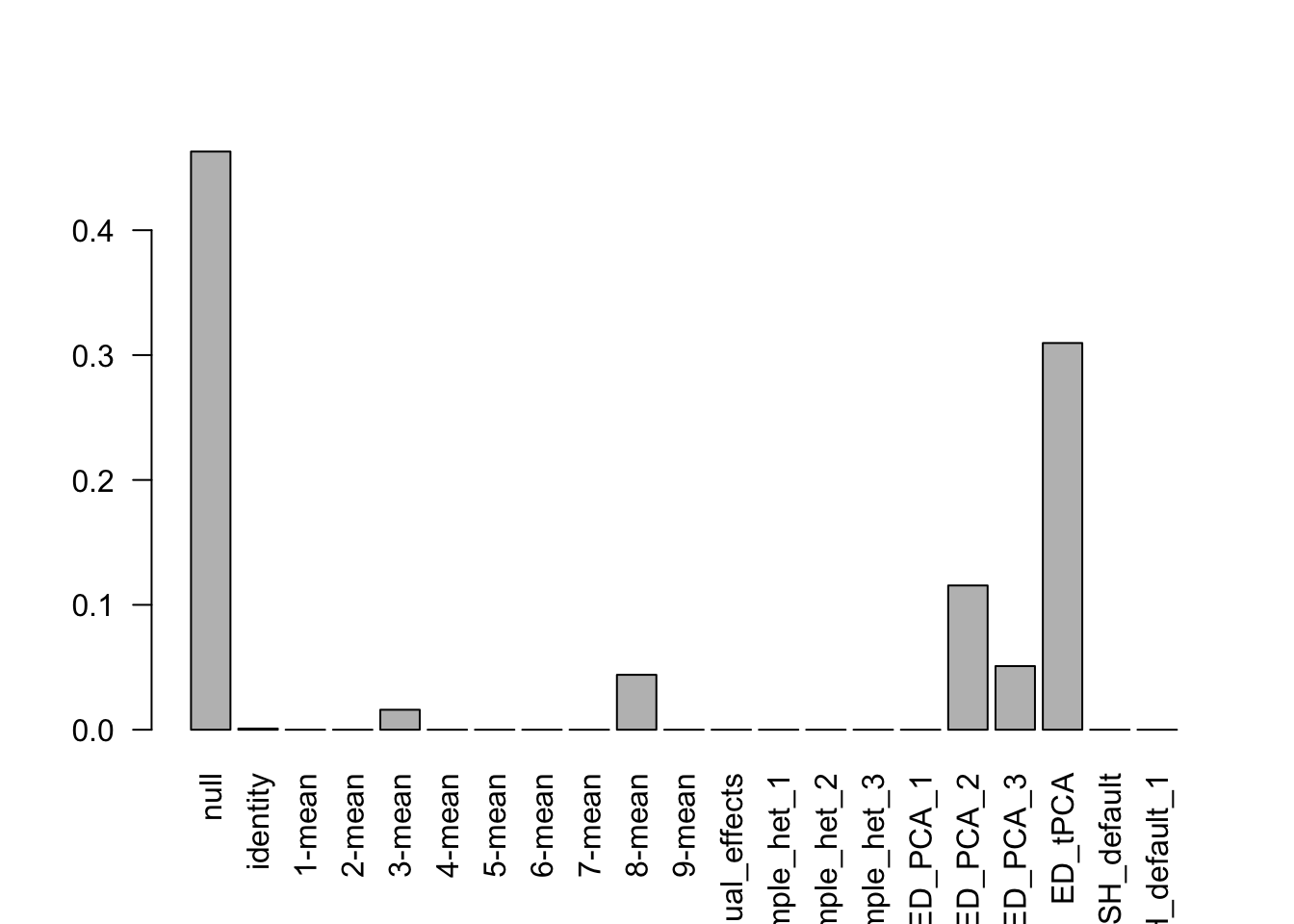
barplot(get_estimated_pi(Indep.9), las=2)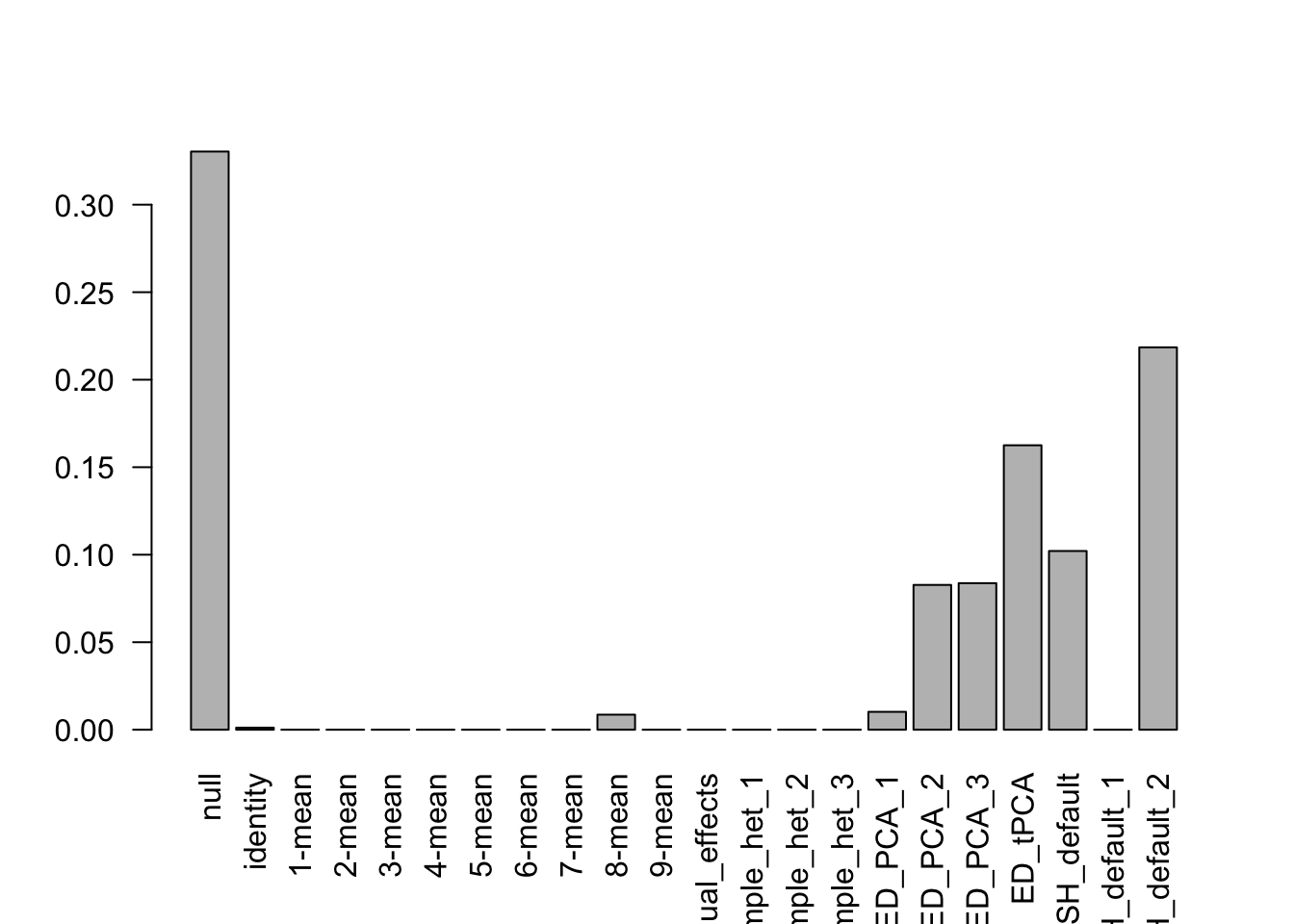
barplot(get_estimated_pi(Const.10), las=2)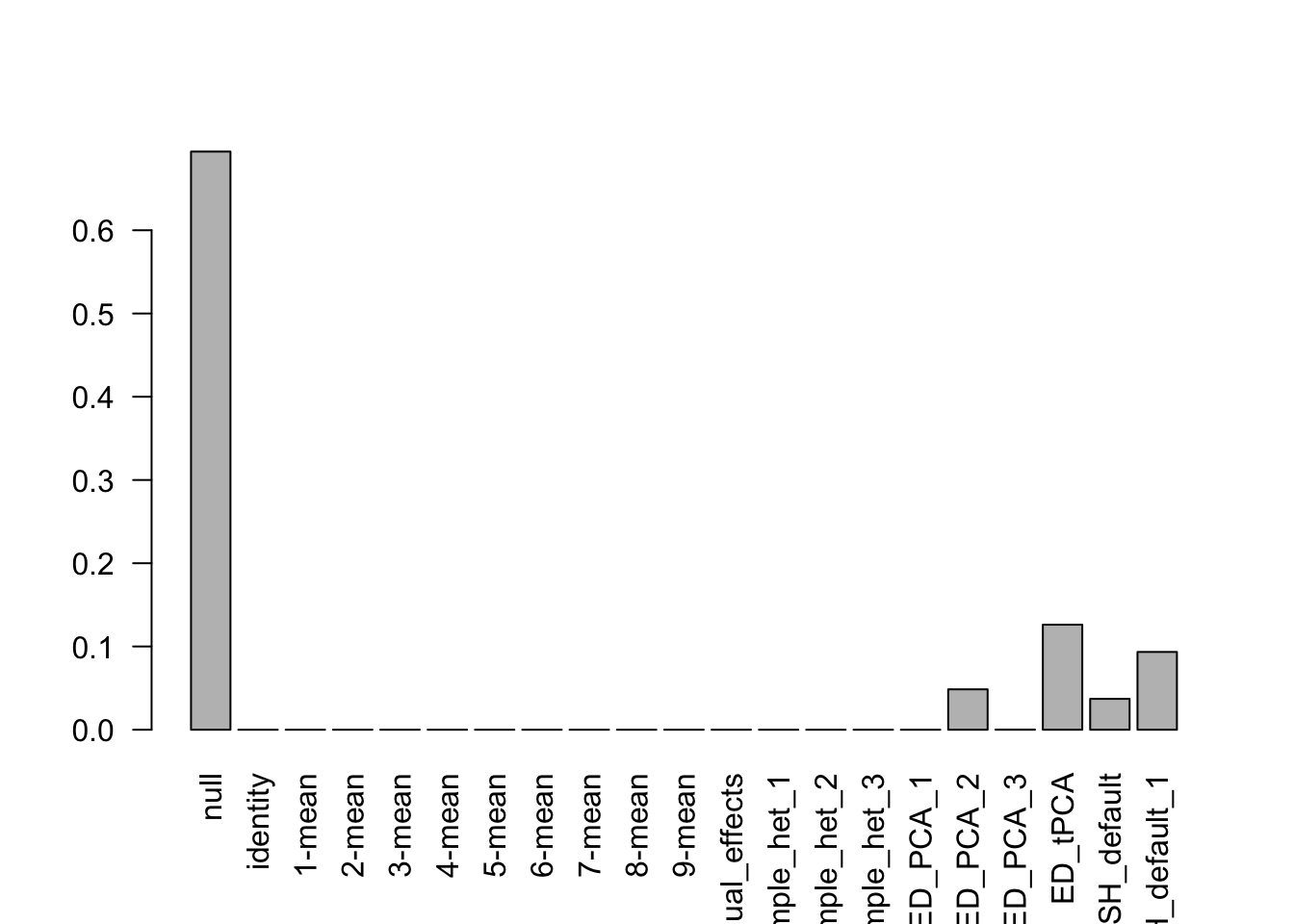
barplot(get_estimated_pi(Const.9), las=2)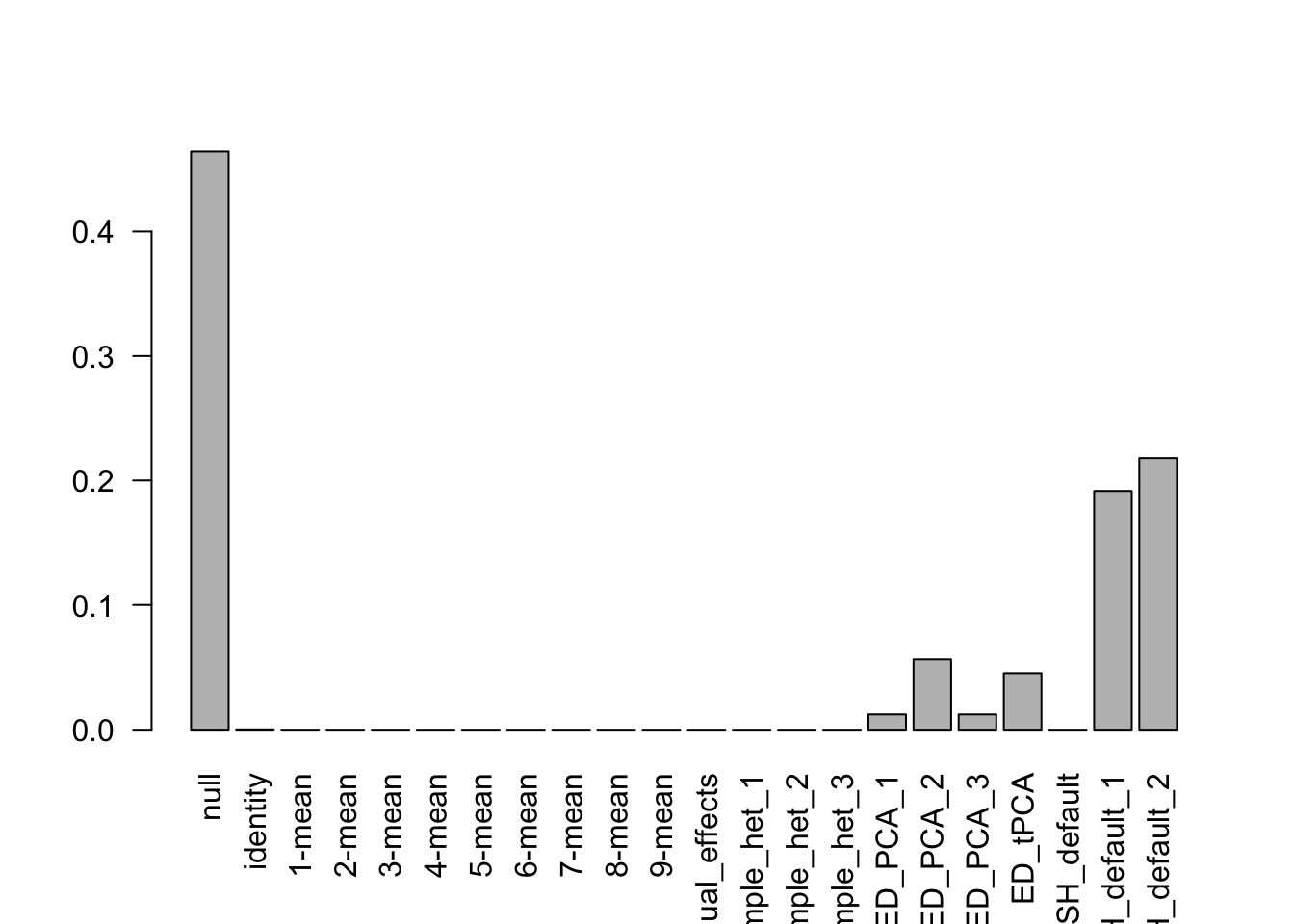
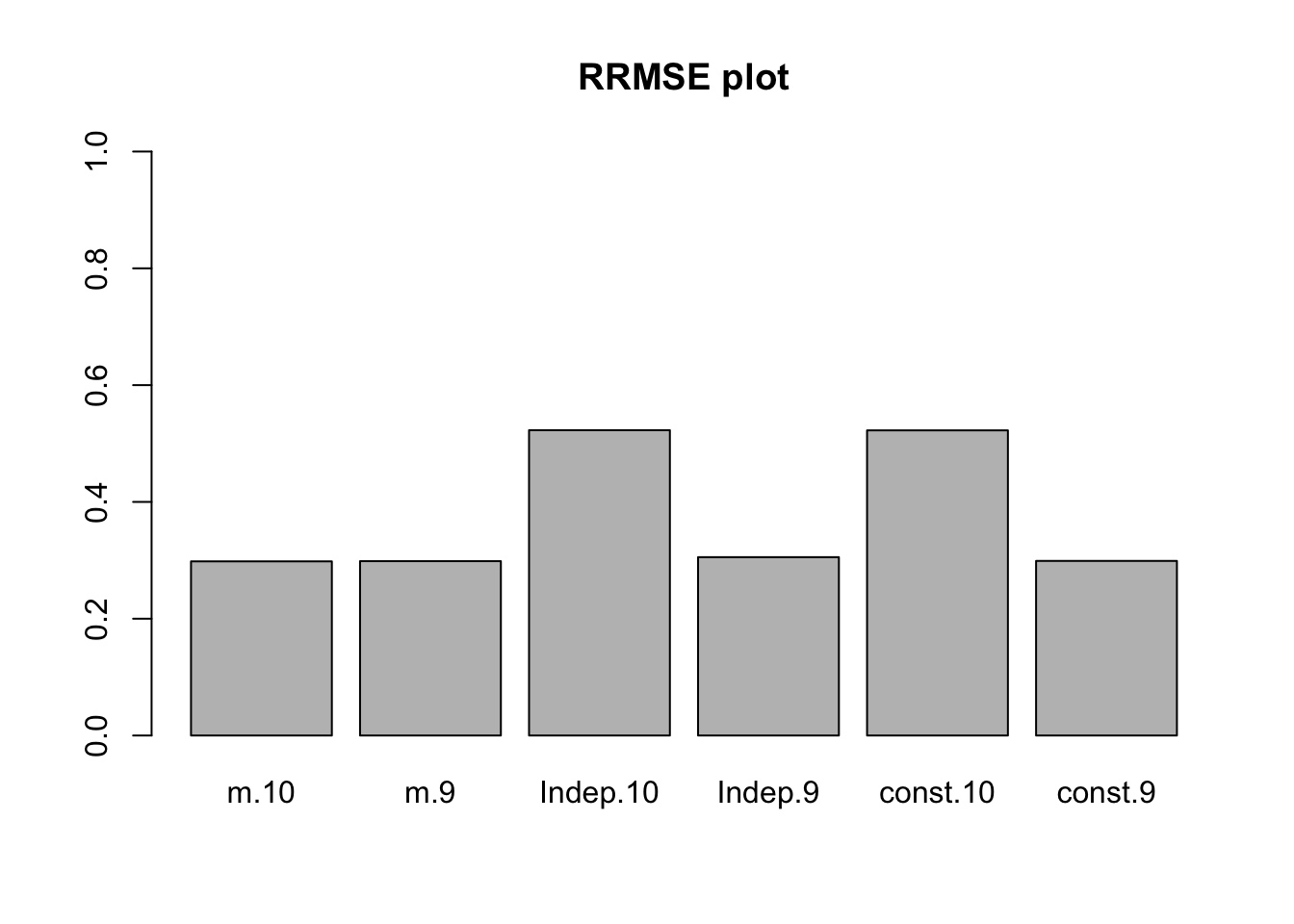
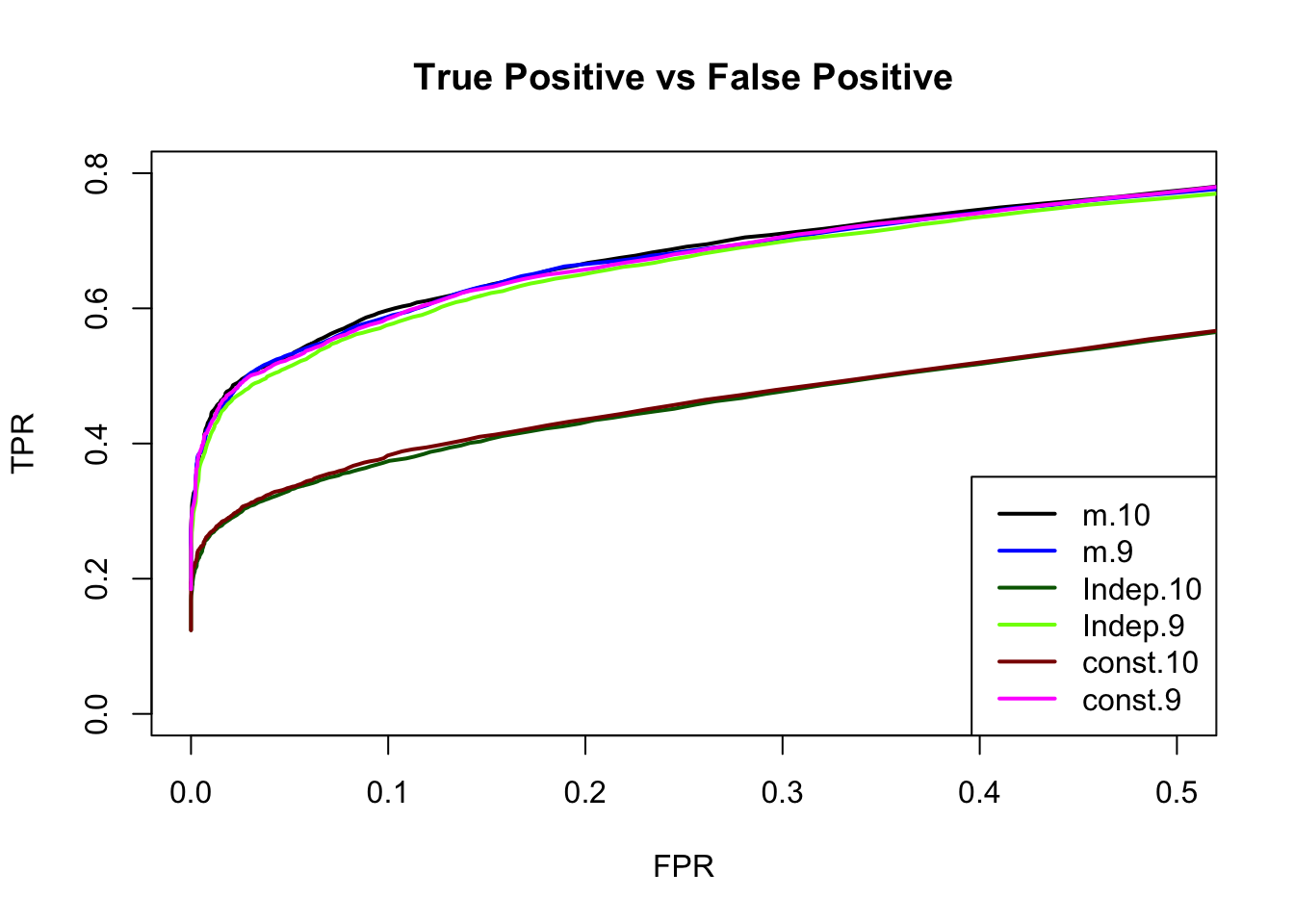
Each effect is treated as a single discovery across all conditions
thresh.seq = seq(0, 1, by=0.005)[-1]
contrast.10 = contrast.9 = indep.10 = indep.9 = const.10 = const.9 = matrix(0,length(thresh.seq), 2)
colnames(contrast.10) = colnames(contrast.9) = colnames(indep.10) = colnames(indep.9) = colnames(const.10) = colnames(const.9) = c('TPR', 'FPR')
for(t in 1:length(thresh.seq)){
contrast.10[t,] = c(sum(get_significant_results(m.10, thresh.seq[t]) > 1000)/1000,
sum(get_significant_results(m.10, thresh.seq[t]) <= 1000)/1000)
contrast.9[t,] = c(sum(get_significant_results(m.9, thresh.seq[t]) > 1000)/1000,
sum(get_significant_results(m.9, thresh.seq[t]) <= 1000)/1000)
indep.10[t,] = c(sum(get_significant_results(Indep.10, thresh.seq[t]) > 1000)/1000,
sum(get_significant_results(Indep.10, thresh.seq[t]) <= 1000)/1000)
indep.9[t,] = c(sum(get_significant_results(Indep.9, thresh.seq[t]) > 1000)/1000,
sum(get_significant_results(Indep.9, thresh.seq[t]) <= 1000)/1000)
const.10[t,] = c(sum(get_significant_results(Const.10, thresh.seq[t]) > 1000)/1000,
sum(get_significant_results(Const.10, thresh.seq[t]) <= 1000)/1000)
const.9[t,] = c(sum(get_significant_results(Const.9, thresh.seq[t]) > 1000)/1000,
sum(get_significant_results(Const.9, thresh.seq[t]) <= 1000)/1000)
}
| Version | Author | Date |
|---|---|---|
| 43ebe81 | zouyuxin | 2021-03-30 |
delta.10.median = t(apply(simdata.10$B, 1, function(x) x-median(x)))
deltahat.10.median = t(apply(simdata.10$Bhat, 1, function(x) x-median(x)))
data.10.median = mash_set_data(Bhat = deltahat.10.median, Shat = sqrt(0.5))
U.c = cov_canonical(data.10.median)
m.1by1 = mash_1by1(data.10.median)
strong = get_significant_results(m.1by1)
U.pca = cov_pca(data.10.median,3,subset=strong)
U.flash = cov_flash(data.10.median, subset=strong)
U.ed = cov_ed(data.10.median, c(U.pca, U.flash), subset=strong)
m.median.10 = mash(data.10.median, c(U.c,U.ed)) - Computing 2000 x 397 likelihood matrix.
- Likelihood calculations took 0.13 seconds.
- Fitting model with 397 mixture components.
- Model fitting took 6.86 seconds.
- Computing posterior matrices.
- Computation allocated took 0.04 seconds.sum(get_significant_results(m.median.10) < 1001)[1] 380
sessionInfo()R version 4.0.3 (2020-10-10)
Platform: x86_64-apple-darwin17.0 (64-bit)
Running under: macOS Big Sur 10.16
Matrix products: default
BLAS: /Library/Frameworks/R.framework/Versions/4.0/Resources/lib/libRblas.dylib
LAPACK: /Library/Frameworks/R.framework/Versions/4.0/Resources/lib/libRlapack.dylib
locale:
[1] en_US.UTF-8/en_US.UTF-8/en_US.UTF-8/C/en_US.UTF-8/en_US.UTF-8
attached base packages:
[1] stats graphics grDevices utils datasets methods base
other attached packages:
[1] mashr_0.2.45 ashr_2.2-51 workflowr_1.6.2
loaded via a namespace (and not attached):
[1] softImpute_1.4 tidyselect_1.1.0 xfun_0.22 reshape2_1.4.4
[5] purrr_0.3.4 splines_4.0.3 lattice_0.20-41 colorspace_2.0-1
[9] vctrs_0.3.8 generics_0.1.0 htmltools_0.5.1.1 yaml_2.2.1
[13] utf8_1.2.1 rlang_0.4.11 mixsqp_0.3-46 later_1.1.0.1
[17] pillar_1.6.0 glue_1.4.2 DBI_1.1.1 trust_0.1-8
[21] plyr_1.8.6 lifecycle_1.0.0 stringr_1.4.0 munsell_0.5.0
[25] gtable_0.3.0 mvtnorm_1.1-1 evaluate_0.14 knitr_1.31
[29] httpuv_1.5.5 invgamma_1.1 irlba_2.3.3 fansi_0.4.2
[33] highr_0.8 Rcpp_1.0.6 promises_1.2.0.1 scales_1.1.1
[37] rmeta_3.0 horseshoe_0.2.0 truncnorm_1.0-8 abind_1.4-5
[41] fs_1.5.0 deconvolveR_1.2-1 flashr_0.6-7 ggplot2_3.3.3
[45] digest_0.6.27 stringi_1.5.3 dplyr_1.0.5 ebnm_0.1-36
[49] grid_4.0.3 rprojroot_2.0.2 tools_4.0.3 magrittr_2.0.1
[53] tibble_3.1.1 crayon_1.4.1 whisker_0.4 pkgconfig_2.0.3
[57] ellipsis_0.3.2 Matrix_1.3-2 SQUAREM_2021.1 assertthat_0.2.1
[61] rmarkdown_2.7 R6_2.5.0 git2r_0.28.0 compiler_4.0.3